Co-authored by Geoff Neupert, former StrongFirst Certified Master Instructor
At StrongFirst we never focused on fat loss—and got it anyway as a side effect of our strength and power focused training until Geoff Neupert, former StrongFirst Master Instructor and the author of excellent online course on double kettlebell training Kettlebell STRONG! came across a study by Izumiya et al. (2008).
The Fat Loss Methods of World-Class Weightlifters
Neupert, an accomplished Olympic lifter himself, pointed out how lean weightlifters are — all without the dishonor of aerobics. Indeed, the Soviet national team had a standard of 6-7% body fat for everyone but heavyweights — and David Rigert, one of the greatest weightlifters of all time, had 4% body fat at a bodyweight of 200-220lbs. He called it “dry, fighting weight.”
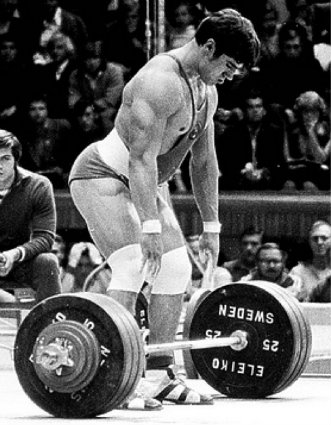 What is extraordinary about the Japanese study is “… a reduction in accumulated white adipose tissue and improvements in metabolic parameters independent of physical activity or changes in the level of food intake.” (The emphasis is mine.)
What is extraordinary about the Japanese study is “… a reduction in accumulated white adipose tissue and improvements in metabolic parameters independent of physical activity or changes in the level of food intake.” (The emphasis is mine.)
Neupert, who would become our resident fat-loss expert, has commented, “So you don’t have to rely on things like EPOC, otherwise known as ‘the afterburn effect,’ and you don’t have to rely on getting your heart rate up to burn off calories. And without changing your diet — or going on a diet! How cool is this?”
(Of course, eating clean will get you ripped faster. Here is Rigert’s typical breakfast: two raw eggs, two steaks with no side dishes, 200g (almost half a pound) of sour cream, a cup of coffee, and mineral water.)
More great news: you do not have to wait until you have built as much muscle as a Russian weightlifter. The researchers concluded that, “The results from the current study indicate that modest increases in type 2B skeletal muscle mass can have a profound systemic effect on whole-body metabolism and adipose tissue.” (The emphasis is mine.)
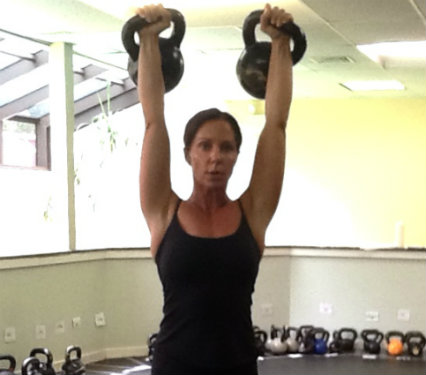
So how do we hammer our fast fibers? There are only three ways: heavy, explosive, or a combination of both. All of the training plans by StrongFirst’s most experienced instructors fall into these categories. Geoff has kindly agreed to publish one of his.
A Simple Strength Program
By Geoff Neupert, CSCS, former StrongFirst Master Instructor
One of the best ways to increase overall body strength is to spend some time with the Clean + Press and the Front Squat. You can either use a single kettlebell or a pair of kettlebells. My preference is always a pair of kettlebells for the intermediate kettlebell user because of the greater systemic strength effect. That means there is more demand placed on the body to get stronger, so it does.
Here’s how the program is laid out:
A1. Clean + Press
A2. Front Squat
Use your 5RM on the Press. Set a timer for 30 minutes. You will alternate between sets of A1 and A2: Perform a set of C+P’s, then rest. Then perform a set of FSQ’s, then rest. Then repeat until time expires. Perform as many sets as possible while remaining as fresh as possible. Refuse to “grind” — keep your rep speed the same. If it slows down, rest more between sets.
Week #1:
- Day 1: Ladders. 1, 2, 3
- Day 2: Sets of 1
- Day 3: Sets of 2
Week #2:
- Day 1: Ladders. 1, 2, 3
- Day 2: Sets of 1
- Day 3: Sets of 3
Week #3:
- Day 1: Ladders. 1, 2, 3, 4
- Day 2: Sets of 2
- Day 3: Sets of 3
Week #4:
- Day 1: Ladders. 1, 2, 3, 4, (5)
- Day 2: Sets of 2
- Day 3: Alternate between sets of 3 and 4 if possible.
Week #5:
- Day 1: Perform 3×3.
- Day 2: Perform a new RM with the same kettlebell(s) you used for the previous 4 weeks. Or you may go up to a heavier kettlebell(s) and perform a new RM.
Some Notes:
You may be tempted to rush between reps and turn this into some kind of MetCon. Don’t. Remember to stay fresh.
A simple method to “stay fresh” is to use “Fast & Loose” drills between sets.
Week 4, Day 1, you’ll see “Ladders. 1, 2, 3, 4, (5).” That means if you feel like you can do a set, or sets of 5, then do so. If you don’t think you can, then don’t.
Week 4, Day 3, you’ll see “Alternate between sets of 3 and 4 if possible.” Use wisdom here. If you can’t alternate, don’t force it. Drop back down to 3 reps.
You may be wondering how many sets you should do per workout. I don’t know. I prefer to use “autoregulation,” meaning, we all have different training backgrounds and work capacities. What is easy for one may be hard for another, so all I do is specify the reps for you.
What should you do on your “off” days? Not much. Restoration work primarily. Easy stretching, mobility work, yoga, or my favorite, Original Strength. Just keep it light and easy. And certainly no MetCon.
Enjoy!
May you reach your “dry, fighting weight” without the dishonor of dieting and aerobics!
# # #
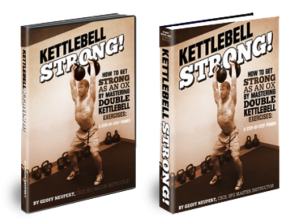
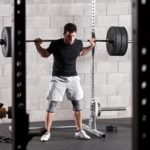
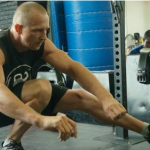
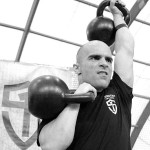
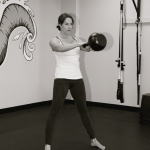

Any thoughts on adding in pull ups to this, to match the ladders; c &p x 1 fsq x1 pull up x 1. C & p x2 fsq x 2 pull up x2………
Singles – add weight to the pull up….
Many Thanks
How the ladder (1,2,3) should look with one kettlebell
Like this
1 C&P left, 1 C&P right, 1 SQ left, 1 SQ right, 2 C&P left, 2 C&P right…
or
1 C&P left, 1 SQ left, 1 C&P right, 1 SQ right, 2 C&P left, 2 SQ left, 2 C&P right, 2 SQ right…
???
Since he recommend double bells,I think its came out with single bells like 1c&p left hand 1c&p right hand and the same with squat
Hello,
Thanks for the wealth of info.
Just to make sure I get it right:
For Day 1: Ladders. 1, 2, 3, does it look like this?
C&P x1 – SQ x1 | C&P x2 – SQ x2 | C&P x3 – SQ x3
And repeat as many of those ladders as possible within 30 minutes.
Thanks you.
BD
I was wondering the same thing – whether it is what you asked or is it (C&P ladder, Squat ladder, C&P ladder, …)? My guess is what you said, which follows the pattern of Rite of Passage with {C&P + Pullups}.
hk, yes. C&P means that the movement being discussed is the “clean and press”, so every rep consists of one clean followed by one press. When we want one clean and multiple presses, we just talk about press reps and assume you will do one clean to get the bells to the starting position for your set of presses.
-S-
Is there a clean after every press?
IIB, or not IIB: that is the question!
That Izumiya study is dynamite! Great find. I’ve felt through my own experience that more fast-twitch muscular typically means it’s way easier to maintain healthy body fat levels (not talking bodybuilding competition levels, which aren’t healthy anyway). I just never thought of building muscle as an approach to get down to a healthy body fat level to begin with. It’s seems so obvious now that you made the connection for me.
It’s unfortunate that for many people “weightlifter” conjures up images of Alekseyev but not Rigert. Both are highly skilled and very successful in their sport. It’s just the super heavyweights have different attributes required for success, and overall mass is one of them. All elite athletes do what’s required for their sport, and not all of it is considered healthy in the context of average Joes and Janes looking to live a long, strong, pain-free life where we can handle our daily physical challenges with ease. We’ve all become so focused on the visual, that somehow a person is seen as a better/more talented athlete/person with a clearly superior training program if they look more like a model.
Keep up the great work, gentlemen!
Scott
zombie-proof: be ready when it all goes down
This one seems to be very promising!
Some time ago I was running BB FS+(KB C&P/pull-ups) programm based on Wendler’s 5/3/1 for FS and Pavel’s ETK for C&P (with pull-ups). Swings/snatches from ETK were included as well. It worked excellent!
So, are we just completely ignoring all of the overweight, downright obese weightlifters? Did they not get the memo they are supposed to be ripped from just doing their sport?
@Stephanie – Yeah, we are. Because they’re mostly super heavyweights, which make up ONE of eight different men’s weight classes and ONE of eight different women’s weight classes.
The rest are pretty lean, the exception might be the heavyweight categories – 105kg in Men’s and 75kg in women’s. And they get that way from practicing their sport, not from hardcore dieting and excessive (or any) MetCon.
Hope that makes sense.
Hi guys, I am running this program with my 50 kg (110 pounds) sandbag. Get back to you four weeks later
with results.
Third week in and liked it so far. A question for them wise guys: how would you continue after this program is finished? Re-run the same with heavier sandbag or do something completely different? Thanks!
Mire,
Do something different. A hypertrophy program would be ideal after this “fat loss” program and have you primed and ready to put on some muscle.
So here is promised wrap up: I definitely ended up stronger and (beacuse of eating and progressive shortening of rest periods) bit more muscular.
And exactly as you suggest I am starting the ‘EDT’ type of training now.
Thanks for the explanation. I get it now! 🙂
Gah. Can’t wait to plug this in.
Geoff, would this be a good phase 2 option for STRONG!?
@James O – Sorry for the late response – haven’t been able to post.
No, the phase 2 option in “STRONG!” is the best option for phase 2 in “STRONG!” if that’s what you’re asking. If you’r asking “can I do this AFTER “STRONG!”? Sure can.
Thanks as always, Geoff.
One of my very favourite Strongfirst posts so far! Great stuff Pavel and Geoff!
Nate,
In my humble but very unprofessional opinion there isn’t a movement pattern the clean and press doesn’t hit to at least some degree! It’s that powerful and all encompassing.
That’s true Carl. For some reason, I was forgetting that the “Clean” in the “Clean & Press” is a hinge movement. It definitely takes care of that. I just hate not doing some Get-ups, Swings and Pull-ups during this time.
However, I think I’ve found a way to work them in. I could do Get-ups for a few heavy sets as part of my warm-up before the DC&P and DKFS workouts 1-2x/week. And I could do some pull-up ladders on Saturday as Pavel had suggested to someone who had a similar question regarding the Total-Tension Complex. As for the Swing, I could “practice” a few heavy, low rep sets as part of the warm-up or on the day I do the pull-ups.
Geoff and Pavel, your thoughts?
Sorry, none of you kettlebell people sport any respectable amount of muscle at all. Who are you kidding? Fat loss is 100% nutrition, exercise is irrelevant to fat loss.
I went from a size 36 pants to size 34 pants in less than 3 months doing only S&S 6 days a week. Haven’t changed my diet one bit. My experience shows that fat loss is not 100% nutrition.
Hello Eric,
Can you tell me what S&S is?
Thank you..
Pavel’s book, Kettlebell Simple and Sinister.
I totally love this! It goes along with much of what I’ve been reading, researching, and practicing in different ways the last few months.
Although the DC&P and DKFS do a good job of “blanket bombing” the body, I see that there are several movement patterns being neglected during this 5-week program (Hinge – Swing / Pull – Pull-ups / Get-ups).
Could the “off” days could be used as “Recharge/Variety” days for the above three movements using heavy weights, low reps, and plenty of rest?
Or, could one of these movements be added to the program each day throughout the week like this:
Mon: DC&P, DKFS + Pull-ups
Wed: DC&P, DKFS + Swings
Fri: DC&P, DKFS + Get-ups
Geoff, can you give your recommendations on this?
Also, can this repeated again after the 5 weeks? Or do you suggest moving to something else (if so, what)?
Thanks!
Nate
Ok excuse my ignorance, but what is a ladder? Im not understanding the nice workout you laid out for everyone. I think i would want to do it if i totally understood it. Also while im not understanding. How are there sets if im supposed to do as many as possible with good form and speed in 30 min? Im sorry for the dumb question but it would be helpful to me. Thx in advance!
Carlos, ladder means you increase the reps in every set, so it is like 1 C&P, rest, 1 FSQ, rest, 2 C&P, rest, 2 FSQ, rest, etc.
As many as possible with good form means you should do as many sets in 30 minutes as you can, depending on your strength and current form, but instead of chasing the numbers of sets, you should take care of keeping the form right.
With all my respect, the programs published here are for intermediate users, so if you don’t even understand the article, I would kindly recommend to visit a SFG instructor first.
Carlos, see Pavel’s book, “Enter The Kettlebell” for an in-depth explanation of ladders and what you can expect to accomplish with them.
The format, simply, is derived from doing a workout with a partner in the following format – I do 1 rep, you do 1 rep, I do 2 reps, you do 2 reps, I do 3 reps, you do 3 reps, etc. You can terminate the ladder at whatever point you feel is appropriate. It helps achieve a high volume of training without doing any individual set for high reps – a ladder of 1-2-3-4-5 means you’ve done 15 reps but never more than 5 in a single set, and the volume will stand you in good stead whether your goal is increased total reps in a single set or increased 1RM.
When you do a ladder workout by yourself, just take approximately as much rest as your work time.
The equal parts work and rest are, of course, just general guidelines. You could, e.g., do a ladder workout with 2 or more imaginary or real partners, which would give you longer rests than work, an approach well-suited to strength training with minimal hypertrophy. Or you could cut the rests back so that they’re less than the work periods, an approach that might demand a lighter weight but would instead give you more muscle pump and perhaps better conditioning as well.
Link to ETK book Enter The Kettlebell